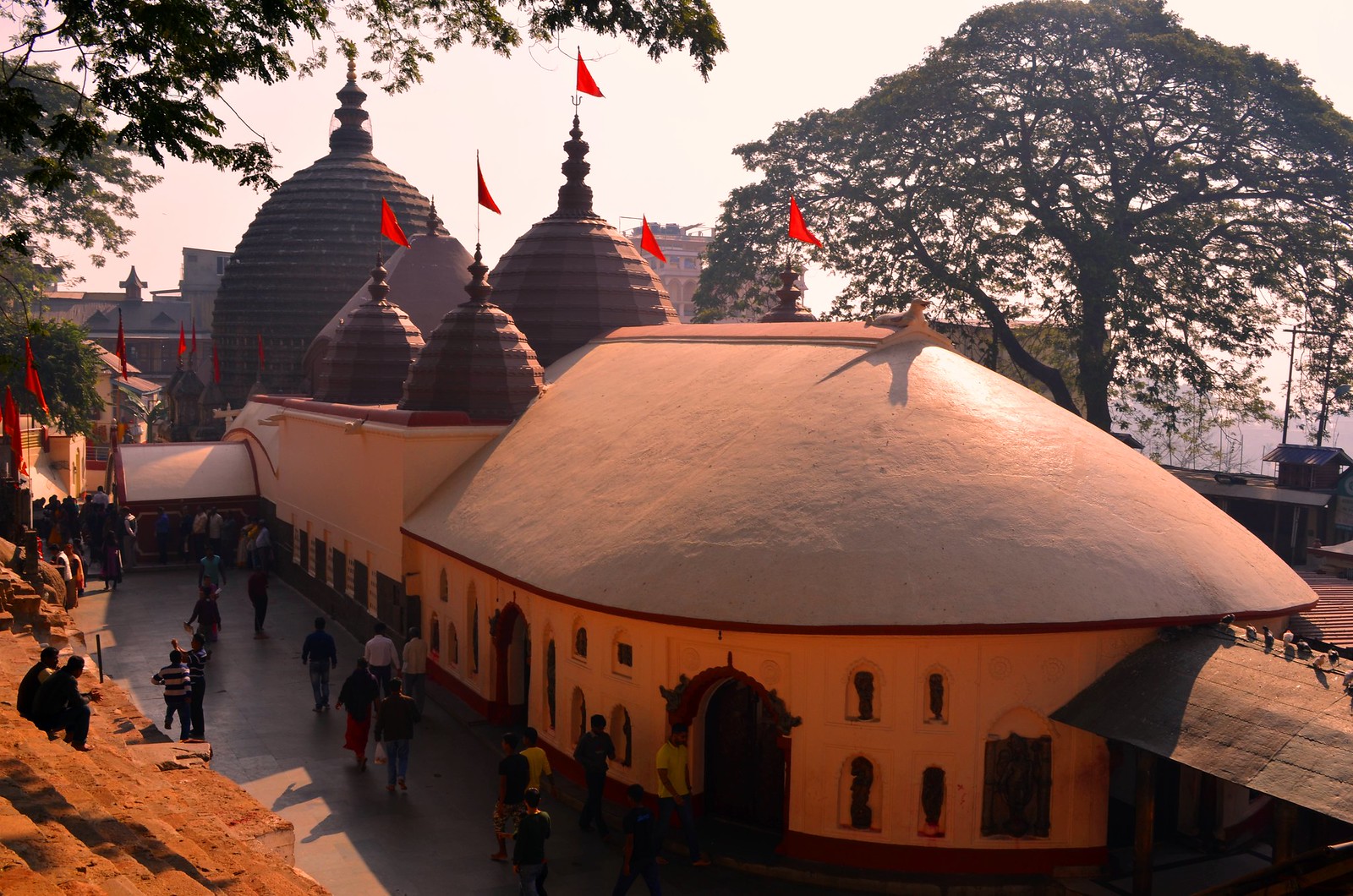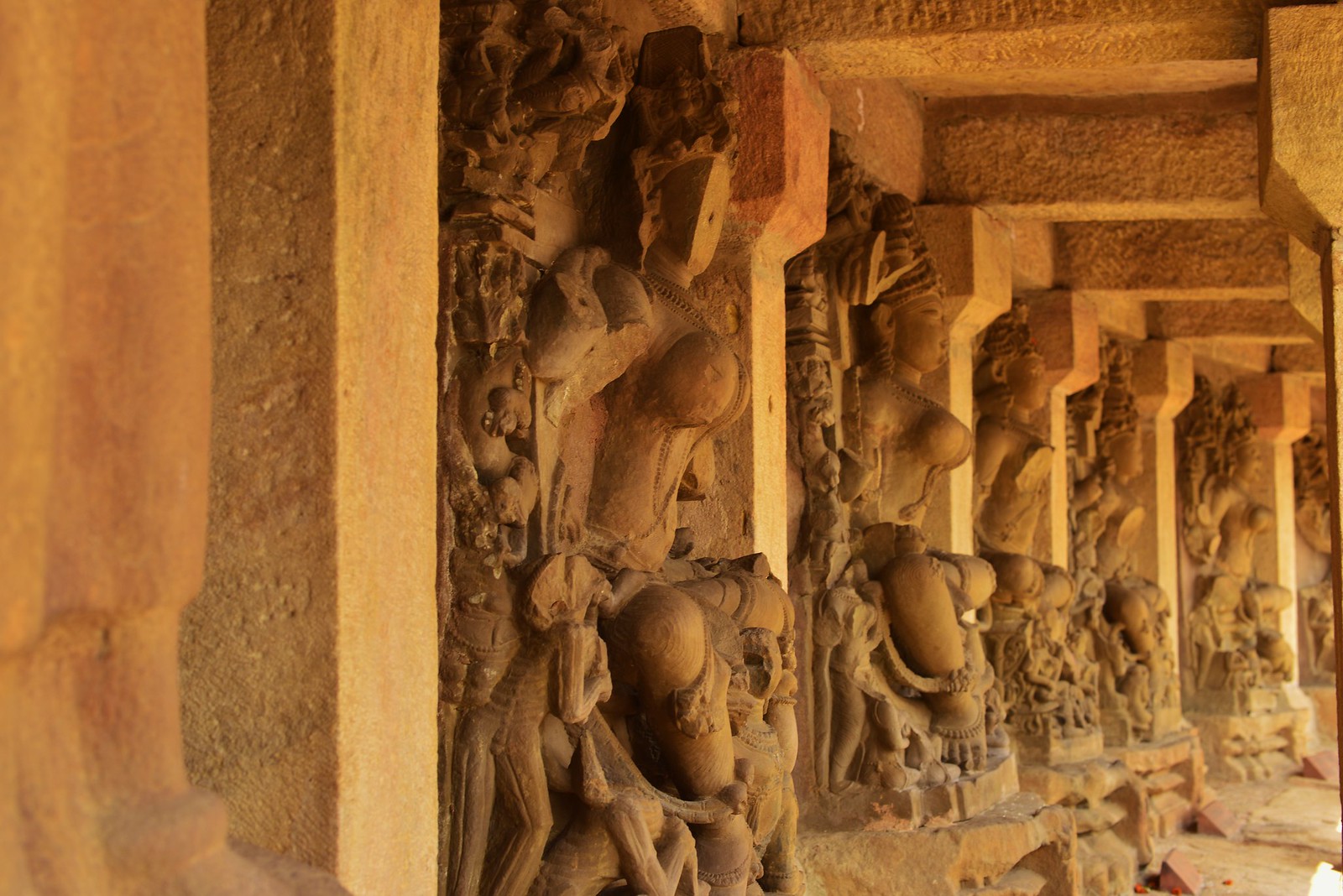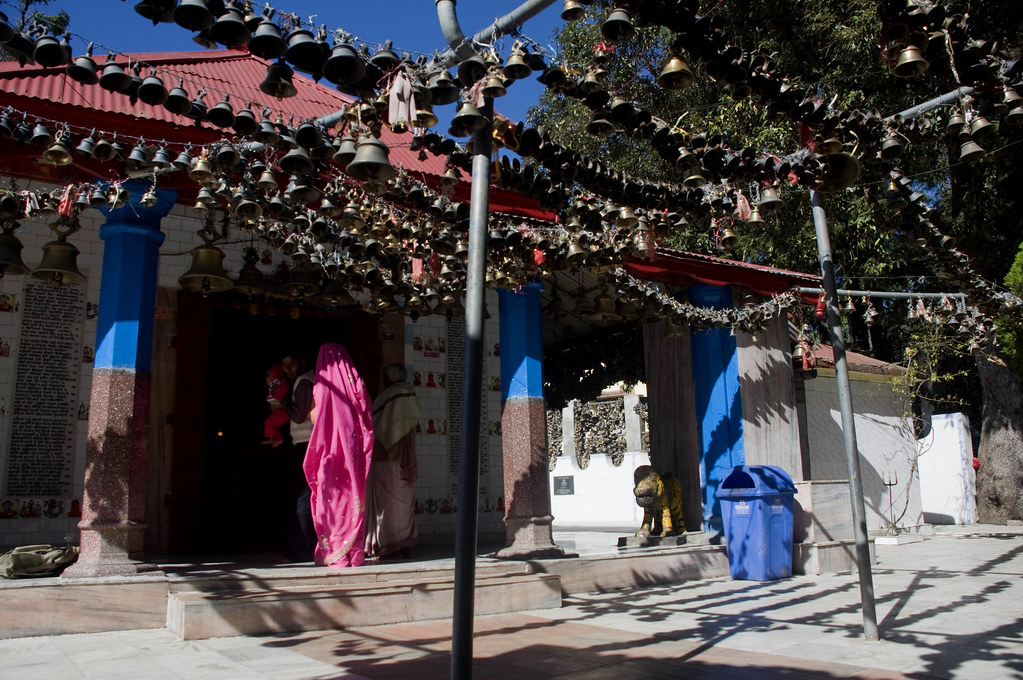1. Kamakhya Devi Temple, Guwahati
The Kamakhya Temple in Guwahati is one of the most venerated Shakti shrines in India, and is regarded as one of the Shakti Peethams associated with the legend of Shiva and Daksha Yagna. There is no image of Shakti here. Within a corner of a cave in the temple, there is a sculptured image of the Yoni of the Goddess, which is the object of reverence. A natural spring keeps the stone moist.

Image source: Flickr
The temple has a beehive like shikhara. Some of the sculptured panels seen here are of interest. There are images of Ganesha, Chamundeswari, dancing figures etc.
Other temples on the Neelachala hill include those of Tara, Bhairavi, Bhuvaneswari and Ghantakarna. Navratri festival is celebrated with as Durga Puja here. Various rituals are held to worship Goddess Durga.
2. Chausath Yogini Temple, Jabalpur
Chausath Yogini Temple is one of the oldest heritage sites in India. It has a distinct resemblance to the temples of Khajuraho in structure. The temple is the abode of Goddess Durga along with 64 yoginis. It is located near the river Narmada and the famous Marble Rocks in Bhedaghat, some 5 km from Jabalpur. Though the temple has been partially damaged, it speaks greatly of the ancient dynasties that ruled in Jabalpur.

Image source: Flickr
The central temple, now known as Gauri-Shankar temple, is probably built after the original circular temple as suggested by Cunningham. It is located off-center of the inner courtyard, which is indeed very peculiar.
3. Kamalaja Temple, Lonar
Goddess Kamalaja, is an incarnation of Goddess Shakti, and in this form she is believed to have helped Shiva in fighting Demon Tripurasura. A temple dedicated to the Goddess is found near the Lonar Cater in Maharashtra.

Image Source: travel d’globe
Goddess Kamalaja Devi is worshipped on Tuesdays.
The popular belief is that this incarnation of Goddess Shakti got the name Kamalaja as Brahma used to worship Her with Kamal or lotus flowers.
4. Jhula Devi Temple, Ranikhet
Jhula Devi temple is situated at a distance of 7 kilometres from the town of Ranikhet near Chaubatia.
The main deity of this temple is Goddess Durga and is a believed at this temple, that Jhoola Devi has the powers to fulfil the wishes of all her devotees. The temple houses a cluster of holy bells tied to its walls that are known for granting wishes on being ringed. The clangs of these bells are heard till a very long distance.

Image Source: Flickr
The villagers prayed to Maa Durga for protection, and one day Goddess Durga came in a shepherd’s dream and advised him to excavate her idol. The popularity of the temple can be realized by number of bells hanging over the temple walls. The temple priests have to timely shift the old bells to a different place to make room for the new bells that are tied everyday.
5. Chettikulangara Devi Temple, Alleppey
According to the temple’s history , local people of the Chettikulangara went to witness the annual festivities at the Koypallikarazhma Bhagavathi temple, situated a few kilometres from Alleppey.
One important aspect of the Chettikulangara Sree Bhagavathi temple is that the deity appears as Maha Saraswathi in the morning, as Maha Lakshmi at noon and Sri Durga or Bhadrakali in the evening.

Image Source: Youtube
The major festival at Chettikulangara is Kumbha Bharani. This is in the month of March or April. The date is determined according to the Malayalam calendar KollaVarsham. The Chettikulangara Bharani festival is celeberated in the month of Kumbha, on the day which has the star Bharani and hence the name Kumbha Bharani.
6. Danteshwari Temple, Jagdalpur
This is yet another of the 51 Shakti Peethas. The temple gets its name from the fact that Goddess Shakti’s teeth fell at this spot in Chattishgarh, hence the name Danteshwari temple.

Image Source: Jagdalpur Online
This ancient temple is at the confluence of the Dankini and Shankini rivers, about one and a half hours from Jagdalpur. It was built by the Chalukya kings of Bastar in honor of their family Goddess, Devi Danteshwari, who is venerated by both Hindus and tribal’s in the entire Bastar region.
7. Dakshineswar temple, Kolkata
The famous Dakshineswar Kali Temple which houses the Goddess Kali was founded by Rani Rashmoni following a dream she saw when she was about to start on her pilgrimage to Benaras. A long term plan of the Rani materialized which she had longed to perform when her husband died with unfulfilled wish of constructing a Kali temple near Kolkata – ‘The City of Joy’.

Image Source: Maa Durga Wallpaper
The idols of the Gods and the Goddess was decided to be installed on the ‘snana-yatra day’, an auspicious days of the Hindus.
The exceptionally open-minded Rani wished that pilgrims of all casts and religions could offer prayers at the temple. Her dreams were fulfilled since irrespective of religion and castes Dakshineswar is thronged by millions of devotees and admired for its peaceful ambiance.
8. Mansa Devi Temple, Haridwar

Image Source: Manthan Diary
The temple is known for being the holy abode of Manasa, a form of Shakti and is said to have emerged from the mind of the sage (Rishi) Kashyapa. Mansa is regarded as the sister of the Naga (Viper) Vasuki. The term Mansa means wish and it is believed that the goddess fulfils all the wishes of a sincere devotee. Devotees who want their wishes to be fulfilled by Mansa tie threads to the branches of a tree located in the temple. Once their wishes are fulfilled, people come back again to the temple to untie the thread from the tree. Mansa is also offered coconuts, fruits, garlands and incense sticks in order to appease her.
9. Maa Vaishno Devi, Jammu
Vaishno Devi is considered to be one of the holiest pilgrim centers in the country and is visited by over 10 million devotees throughout the year. Devotees have to trek for 12 km to the shrine from the base camp at Katra. The cave temple has three naturally formed rock structures called pindies which represent the deities- Goddess Maha Kali, Goddess Maha Lakshmi and Goddess Maha Saraswati. The temple is situated atop the Trikuta Mountain, 5200 ft above sea level and 60 km north of Jammu in the Katra district of Jammu and Kashmir.

